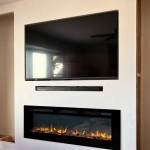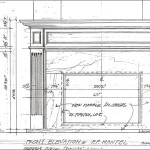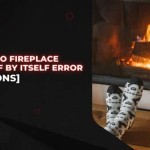How to Fix an Electric Fireplace Insert
Electric fireplace inserts offer a convenient and efficient way to add warmth and ambiance to a room without the complexities of a traditional fireplace. However, like any electrical appliance, they can encounter problems. Understanding common issues and knowing how to troubleshoot them can save time and money, potentially avoiding the need for professional repair. Furthermore, diagnosing and addressing minor problems promptly can prevent them from escalating into more significant and costly repairs.
This article provides a comprehensive guide to troubleshooting and fixing common issues encountered with electric fireplace inserts. It covers various aspects, from basic checks and maintenance to more complex component diagnostics and repair procedures. While some repairs are straightforward and can be performed by homeowners, others require specialized knowledge and skills. It is imperative to exercise caution and prioritize safety when working with electrical appliances. If unsure about any step or component, consulting a qualified electrician or appliance repair technician is highly recommended.
Key Point 1: Preliminary Checks and Common Issues
Before delving into specific components and repair procedures, conducting a series of preliminary checks is crucial. These checks can often reveal the root cause of the problem and avoid unnecessary troubleshooting.
First, verify the power supply. Ensure the electric fireplace insert is properly plugged into a functioning electrical outlet. Test the outlet with another appliance to confirm it's delivering power. If the outlet is controlled by a wall switch, ensure the switch is in the "on" position. Check the circuit breaker or fuse associated with the outlet in the electrical panel. If the breaker has tripped or the fuse has blown, reset the breaker or replace the fuse with one of the appropriate amperage. A tripped breaker or blown fuse could indicate an overload or a short circuit, which requires further investigation.
Inspect the power cord for any signs of damage, such as cuts, fraying, or exposed wires. Damaged power cords pose a serious electrical hazard and must be replaced immediately. Do not attempt to repair a damaged power cord; replacement is the only safe option. Consider using a surge protector to protect the electric fireplace insert from power surges, which can damage sensitive electronic components.
Examine the unit's air vents. Electric fireplace inserts rely on proper airflow for efficient heating and to prevent overheating. Ensure the air intake and exhaust vents are not blocked by furniture, curtains, or other obstructions. Periodically clean the vents with a vacuum cleaner or soft brush to remove dust and debris. Overheating can trigger a safety shut-off mechanism, preventing the unit from operating. Cleanliness is paramount to maintaining the insert's efficiency and longevity.
Check the remote control. Many electric fireplace inserts are equipped with remote controls for convenient operation. Ensure the remote's batteries are fresh and properly installed. Try replacing the batteries with new ones to rule out a battery issue. If the remote still fails to operate, clean the remote's infrared (IR) transmitter and the fireplace insert's IR receiver with a soft cloth. Obstructions or dirt on these components can interfere with the signal transmission. If the remote is still unresponsive, consult the manufacturer's instructions for troubleshooting or consider replacing the remote.
Consider common issues: No heat is a frequently faced problem. This could be caused by a faulty heating element, a tripped thermal overload switch, or a malfunctioning thermostat. The flame effect not working could be caused by a burned-out light bulb, a faulty motor that drives the flame effect, or a malfunctioning control board. Unusual noises, such as squealing, grinding, or clicking, can indicate a problem with the motor, fan, or other moving parts. Intermittent operation, where the unit turns on and off sporadically, can be caused by a loose connection, a faulty sensor, or a failing control board.
Key Point 2: Diagnosing Component Failures
If the preliminary checks do not resolve the issue, further diagnosis of individual components may be necessary. This requires a basic understanding of the electric fireplace insert's internal workings and the use of some basic tools, such as a multimeter.
Heating Element: The heating element is responsible for generating heat. To test the heating element, first disconnect the unit from the power source. Locate the heating element and use a multimeter set to the ohms setting to measure its resistance. A reading of zero or infinite resistance indicates a faulty heating element that needs replacement. Refer to the manufacturer's instructions for the correct resistance value for the specific heating element model. When replacing the heating element, ensure the new element is compatible with the fireplace insert model.
Thermal Overload Switch: The thermal overload switch is a safety device that protects the unit from overheating. If the unit overheats, the switch trips, cutting off power to the heating element. To reset the thermal overload switch, first disconnect the unit from the power source and allow it to cool down completely. Locate the thermal overload switch, which is typically a small button or switch located near the heating element. Press the button to reset the switch. If the switch repeatedly trips, it indicates an underlying overheating problem that must be addressed, such as blocked air vents or a faulty fan.
Thermostat: The thermostat regulates the temperature of the unit. If the thermostat is malfunctioning, the unit may not heat properly or may overheat. To test the thermostat, use a multimeter set to the continuity setting. With the unit disconnected from the power source, connect the multimeter probes to the thermostat terminals. Adjust the thermostat settings to different temperatures. The multimeter should show continuity when the thermostat is calling for heat and no continuity when the thermostat is not calling for heat. If the thermostat does not function as expected, it needs replacement.
Flame Effect Motor: The flame effect motor drives the mechanism that creates the flame illusion. If the flame effect is not working, the motor may be faulty. To test the motor, first disconnect the unit from the power source. Locate the motor and visually inspect it for any signs of damage, such as burned wiring or a seized rotor. Use a multimeter set to the ohms setting to measure the motor's resistance. A reading of zero or infinite resistance indicates a faulty motor that needs replacement. Ensure the replacement motor is compatible with the fireplace insert model.
Light Bulbs: Many electric fireplace inserts use light bulbs to create the flame effect. If the flame effect is dim or nonexistent, the light bulbs may be burned out. Replace the light bulbs with new bulbs of the correct wattage and type. Refer to the manufacturer's instructions for the recommended bulb specifications. Handle the bulbs carefully to avoid breakage. Consider upgrading to LED bulbs for increased energy efficiency and longer lifespan.
Control Board: The control board is the electronic brain of the electric fireplace insert, controlling various functions such as heating, flame effect, and timer. If the control board is malfunctioning, the unit may exhibit a variety of problems, such as intermittent operation, failure to respond to the remote control, or incorrect temperature settings. Diagnosing a faulty control board can be complex and may require specialized equipment and knowledge. In many cases, replacing the control board is the most practical solution. Ensure the replacement control board is compatible with the fireplace insert model and follow the manufacturer's instructions for installation.
Key Point 3: Repair Procedures and Safety Precautions
When performing repairs on an electric fireplace insert, safety must be the top priority. Always disconnect the unit from the power source before attempting any repairs. Use appropriate tools and follow the manufacturer's instructions carefully.
Replacing a Heating Element: To replace a heating element, first disconnect the unit from the power source. Remove the access panel to expose the heating element. Disconnect the wires connected to the heating element. Remove the old heating element and install the new heating element, ensuring it is properly secured. Reconnect the wires to the heating element, ensuring the connections are secure. Replace the access panel. Test the unit to ensure the new heating element is functioning correctly.
Replacing a Flame Effect Motor: To replace a flame effect motor, first disconnect the unit from the power source. Remove the access panel to expose the motor. Disconnect the wires connected to the motor. Remove the old motor and install the new motor, ensuring it is properly secured. Reconnect the wires to the motor, ensuring the connections are secure. Replace the access panel. Test the unit to ensure the new motor is functioning correctly.
Replacing Light Bulbs: To replace light bulbs, first disconnect the unit from the power source. Locate the light bulb access panel, which is typically on the back or side of the unit. Remove the access panel. Carefully remove the old bulb and install the new bulb, ensuring it is properly seated. Replace the access panel. Test the unit to ensure the new bulb is functioning correctly.
Replacing a Thermostat: To replace a thermostat, first disconnect the appliance from the power source. Locate the thermostat, which is usually accessible through a panel. Disconnect the wires from the old thermostat, carefully noting their positions. Install the new thermostat, connecting the wires in the correct positions. Replace the panel. Test the operation of the fireplace to ensure the thermostat is functioning correctly.
General Safety Precautions:
- Always disconnect the unit from the power source before performing any repairs.
- Never work on electrical appliances with wet hands or in damp environments.
- Use appropriate tools for the job.
- Follow the manufacturer's instructions carefully.
- If unsure about any step or component, consult a qualified electrician or appliance repair technician.
- Dispose of old components properly, following local regulations.
- Regularly inspect the unit for any signs of damage or wear.
- Keep the unit clean and free of dust and debris.
By following these guidelines, homeowners can effectively troubleshoot and repair common issues with electric fireplace inserts, ensuring their continued enjoyment and safe operation. However, it is important to remember that electrical repairs can be dangerous, and if there is any doubt about one's ability to perform a repair safely, it is best to seek the assistance of a qualified professional.

How To Install An Electric Fireplace Insert Fireplaces Direct Learning Center

How To Install A Fireplace Insert In An Unconventional Opening Ask This Old House

How To Install An Electric Fireplace Insert Fireplaces Direct Learning Center

Fireplace Fix Easy Tips To Renovate Retrofit And Replace An Old Fire Touchstone Home S Inc

How To Fix The Flames In Your Electric Fireplace Magikflame

Can You Replace Electric Fireplace Insert

How To Install An Electric Fireplace Diy Family Handyman

Fireplace Inserts Everything You Need To Know Full Service Chimney

How To Install A Napoleon Built In Electric Fireplace Fireplaces Direct Learning Center

Modern Flames Redstone Electric Fireplace Insert 30 Woodland Direct
Related Posts








